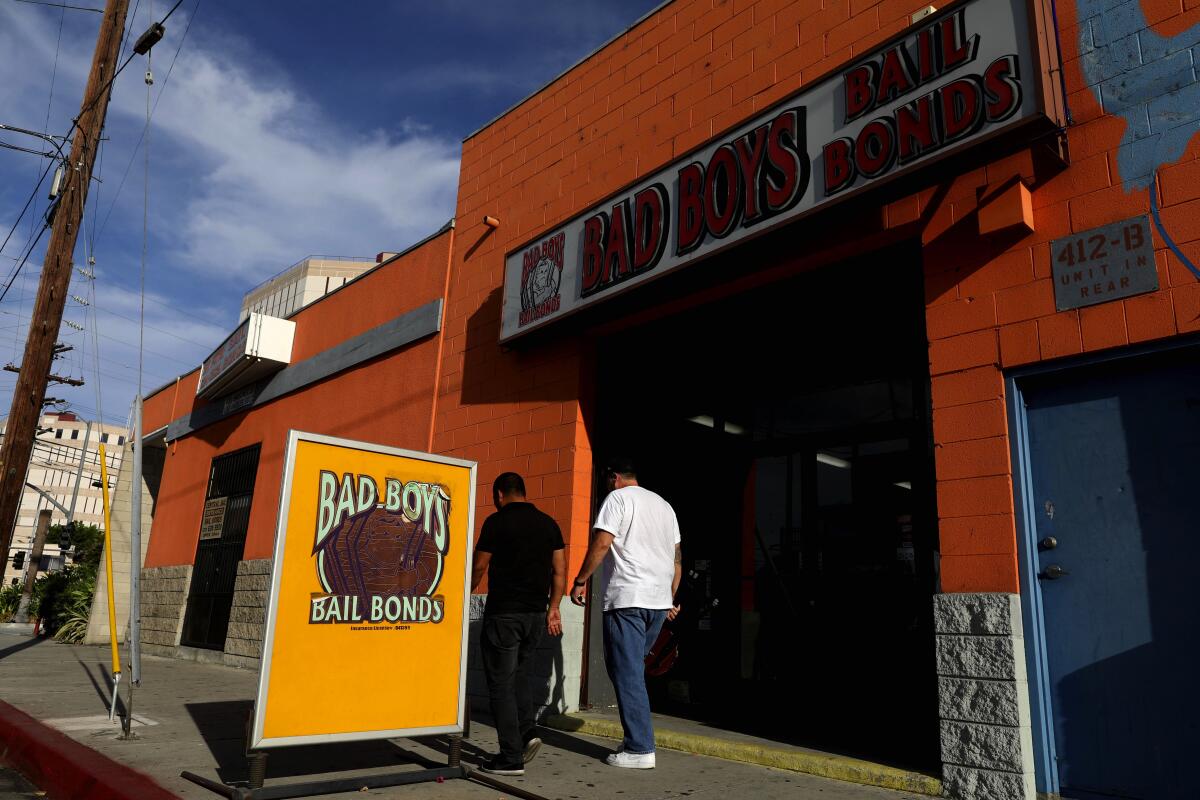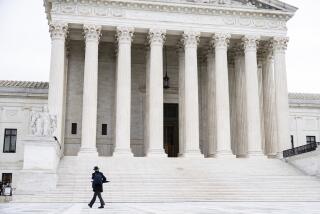Editorial: Court takes a giant step on bail, but more work is needed

The California Supreme Court’s ruling Thursday sharply limiting the use of money bail represents an important and long overdue stride toward more equal justice, but it leaves much unfixed in a still-flawed portion of the criminal justice process.
In setting bail for someone accused of a crime, the justices wrote in the case of In re Humphrey, courts must consider whether that person can actually pay it. In other words, criminal defendants can’t be kept in jail merely because they don’t have enough money to get out.
That principle seems obvious on its face, especially in a nation that proclaims equal justice under law. But money bail — a payment deposited with the court to secure a criminal defendant’s appearance at trial— has been so ingrained in American culture and consciousness through crime novels, movies and bail bond ads that in the popular imagination it’s often considered a natural and necessary part of the criminal justice process, and integral to protecting public safety.
It’s not. Courts can still order that defendants who pose a danger to the public or are a high risk to flee be held in jail without bail until trial if that’s the least restrictive means of securing those legitimate safety goals.
Although courts and prosecutors don’t generally acknowledge it, they often use money bail set at impossibly high amounts as a ruse to keep defendants in jail without ever formally assessing their risk to flee or cause public harm.
Consider, for example, the case of accused sex offender Naason Joaquin Garcia, for whom bail was set at a California record $25 million, then upped to $50 million, and then $90 million, in an obvious bid to prevent the church leader’s release at any price. If prosecutors believe there are legitimate reasons to keep a person locked up before trial, they should present them to a judge, who should order the person detained without bail.
The same was true of Humphrey, who was accused of entering a neighbor’s room in a San Francisco senior housing complex and stealing $5 and a bottle of cologne. Bail was set at $350,000, which seemed silly for the theft of such a small amount.
But Humphrey had a record of violence, and he was accused of immobilizing his victim and preventing him from calling for help, according to George Gascón — formerly San Francisco district attorney and currently Los Angeles’ D.A. In Humphrey’s case and in many others, Gascón said, the proper response may be an order that the defendant be detained regardless of how much money he or she can put up.
Now that the Supreme Court has banned unaffordable bail amounts, the focus will rightly shift to the risk that accused criminals pose. But how are prosecutors and judges to determine whether a person accused of a crime is too risky to release before trial?
One response was SB 10, a 2018 law co-written by Sen. Bob Hertzberg (D-Van Nuys) and Assemblyman Rob Bonta, the Alameda Democrat whom Gov. Gavin Newsom nominated Wednesday as state attorney general. The law, which eliminated money bail, called for risk assessment algorithms and pretrial services programs run by county probation departments. But it was overturned in a 2020 referendum (Proposition 25) financed by the bail bond industry and supported by progressive reformers, who argued that the assessments and the supervision would only worsen racial inequities in the justice system.
Not every accused criminal can be safely released before trial. The need remains for some way to separate the relatively few dangerous defendants from those who can safely be sent home.
And with bail still on the books in the wake of Proposition 25, thousands of people will still be pressed for money to obtain their release in the earliest stages of the process — at the police station, long before they get any chance to appear before a judge. Hertzberg has a new bill that would address that problem in part by permanently setting bail at $0 for many offenses, in line with a pandemic-era rule adopted the state Judicial Council. Bonta has a parallel bill.
Unlike in New York, where courts are always open and a judge or magistrate is always available for a bail hearing, California courts are generally weekday operations, and defendants who ought to be sent home right away will continue to pay, or else wait in jail for a chance to tell a judge that they can’t afford bail.
Meanwhile, counties have widely diverging programs for defendants awaiting trial. Los Angeles County is one of several with pilot programs in place, but many counties do nothing. Pretrial justice and services should not depend on geography any more than on the size of the defendant’s bank account. California lawmakers, take note.
More to Read
A cure for the common opinion
Get thought-provoking perspectives with our weekly newsletter.
You may occasionally receive promotional content from the Los Angeles Times.










